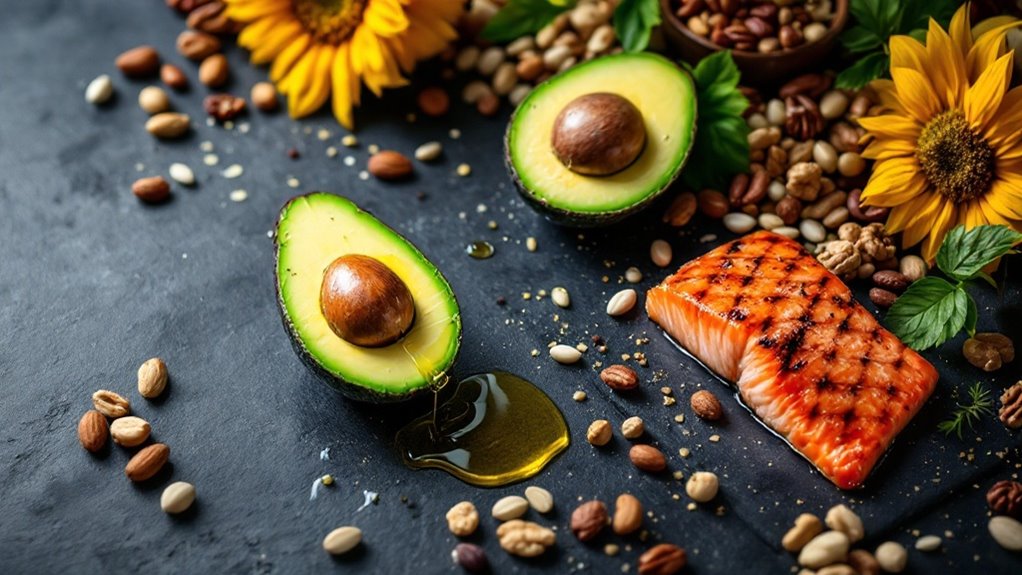Energy-Dense Foods

Energy-dense foods deliver high caloric content in small portions, similar to high-octane fuel for performance vehicles. Common examples include nuts, seeds, avocados, and olive oil, which pack substantial nutrition into compact servings. While beneficial for athletes needing intense energy, these foods require careful portion control for weight management. Smart eaters combine energy-dense options with nutrient-rich, lower-calorie foods for greatest balance. Understanding this power-packed nutrition opens the key to strategic meal planning.
Key Takeaways
- Energy-dense foods contain high calories in small portions, like nuts, seeds, avocados, and olive oil, providing concentrated nutritional value.
- One tablespoon of olive oil contains 120 calories, while a cup of spinach has only 7 calories, illustrating energy density differences.
- Quality energy-dense foods provide essential nutrients and healthy fats, making them valuable for athletes and active individuals.
- Understanding portion sizes of energy-dense foods is crucial for effective weight management and nutritional balance.
- Energy-dense foods should be combined with nutrient-rich, lower-calorie options for a balanced and healthy diet.

Three vital factors determine whether a food is considered energy-dense: its caloric content, nutrient composition, and portion size relative to weight. Understanding these elements is essential for anyone taking control of their nutrition journey, as energy-dense foods pack a powerful caloric punch in relatively small portions.
Energy density isn't just about calories – it's the intricate dance between nutrients, portion size, and weight that defines a food's power.
Think of energy-dense foods like high-octane fuel for a performance vehicle – they deliver maximum energy in a concentrated form. Common examples include nuts, seeds, avocados, olive oil, and fatty fish. While these foods often contain healthy fats and essential nutrients, other energy-dense options like processed snacks, candies, and fried foods provide calories without significant nutritional value.
In the battle of the bulge, energy density becomes a game-changer. A single tablespoon of olive oil contains 120 calories, while an entire cup of spinach provides only 7 calories. This stark contrast demonstrates why understanding energy density is vital for weight management. Navy SEALs and elite athletes strategically use this knowledge, loading up on energy-dense foods during intense training while carefully monitoring portions during maintenance phases.
The concept of energy density operates like a financial investment portfolio – balance is key. While energy-dense foods can be valuable for athletes requiring high caloric intake or individuals struggling to maintain weight, they can pose challenges for those aiming to lose pounds.
Just as a skilled investor diversifies assets, smart eaters combine energy-dense foods with nutrient-rich, lower-calorie options. Modern food processing has created an abundance of energy-dense choices, making mindful eating more important than ever.
Picture walking through a minefield – each step requires careful consideration. Reading labels, measuring portions, and understanding the relationship between volume and calories becomes your tactical advantage. Success in managing energy-dense foods isn't about complete avoidance but rather strategic incorporation into a balanced dietary plan that corresponds with your fitness goals and nutritional needs. Combining energy-dense foods with regular aerobic exercise can help maintain a healthy weight while providing sustained energy for daily activities.
Frequently Asked Questions
Can Energy-Dense Foods Help in Gaining Weight in a Healthy Way?
Energy-dense foods can contribute to healthy weight gain when consumed strategically alongside a balanced nutrition plan.
These calorie-rich options provide efficient means to meet higher caloric needs, especially for individuals struggling to gain mass. Ideal choices include nuts, avocados, lean proteins, whole grains, and healthy oils.
Success requires pairing these foods with regular strength training and proper meal timing while monitoring overall macronutrient balance.
How Do Energy-Dense Foods Affect Blood Sugar Levels Throughout the Day?
Blood sugar levels fluctuate markedly with energy-dense foods. These foods typically contain high amounts of carbohydrates and sugars, causing rapid spikes followed by crashes.
The body releases insulin to manage these surges, which can lead to energy dips, increased hunger, and mood swings throughout the day. Regular consumption may strain the body's glucose regulation system, potentially increasing diabetes risk over time.
What Role Do Energy-Dense Foods Play in Athletic Performance?
Like a steam engine powering through the mountains, energy-dense foods serve as critical fuel for athletes.
These foods provide sustained energy during intense training and competition, helping maintain glycogen stores and prevent premature fatigue.
Athletes strategically consume them before, during, and after workouts to optimize performance, improve endurance, and support muscle recovery.
Timing and portion control remain essential for peak athletic output.
Are There Energy-Dense Foods Suitable for People With Diabetes?
People with diabetes can incorporate healthy energy-dense foods by focusing on options with lower glycemic impact. Nuts, seeds, and avocados provide sustained energy without dramatic blood sugar spikes.
Greek yogurt, lean proteins, and chia seeds offer nutrient-rich alternatives. Portion control remains essential.
Complex carbohydrates like quinoa, paired with healthy fats, create balanced meals that help maintain stable blood glucose levels throughout the day.
Can Energy-Dense Foods Be Part of a Balanced Vegetarian Diet?
Energy-dense vegetarian foods like nuts, seeds, avocados, olive oil, and legumes can absolutely fit into a balanced plant-based diet.
These foods provide essential nutrients including healthy fats, protein, and fiber. Smart portion control allows vegetarians to benefit from their caloric density while maintaining a healthy weight.
Combined with whole grains, fruits, and vegetables, these foods create complete nutrition profiles for vegetarian lifestyles.
Final Thoughts
Energy-dense foods, while often vilified, play an essential role in human survival and athletic performance. Just as a Formula 1 car requires high-octane fuel for peak performance, our bodies sometimes need concentrated energy sources. The key lies in understanding timing and portion control. Remarkably, the same foods that powered ancient warriors through battles now fuel modern athletes to break world records – proving that context, not content, often determines nutritional value.


